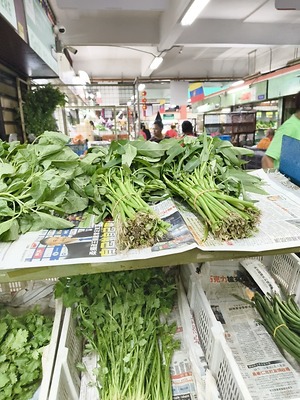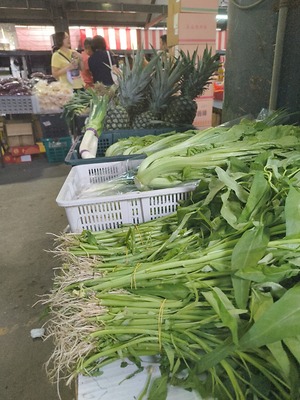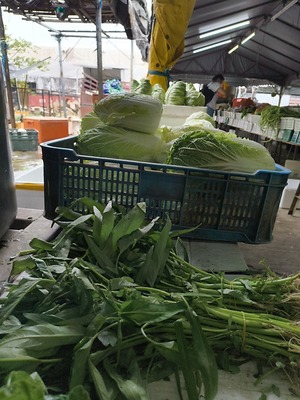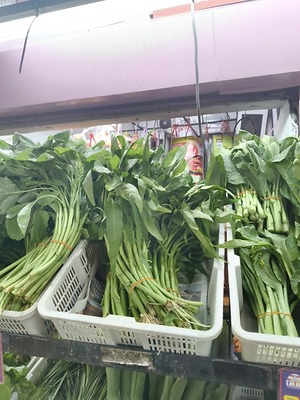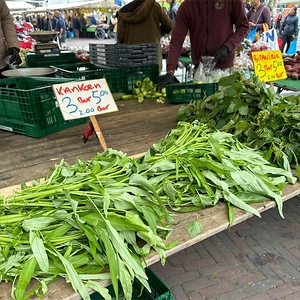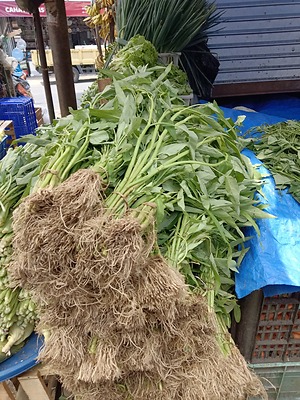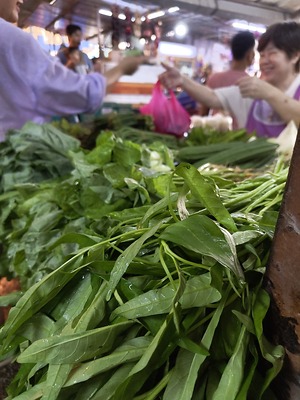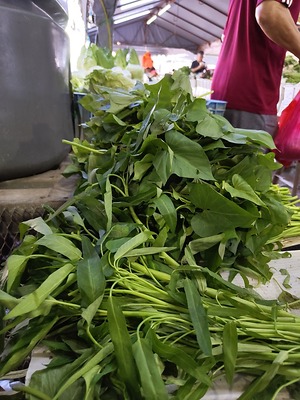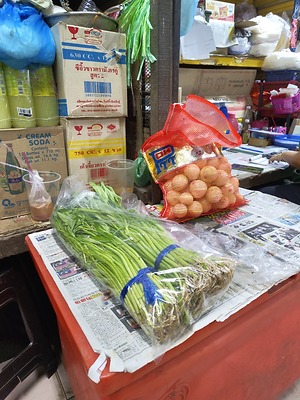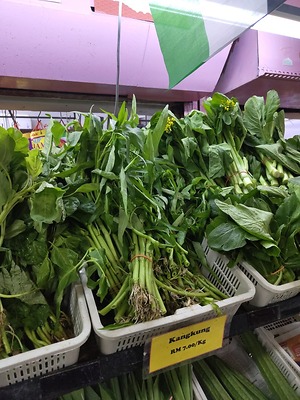

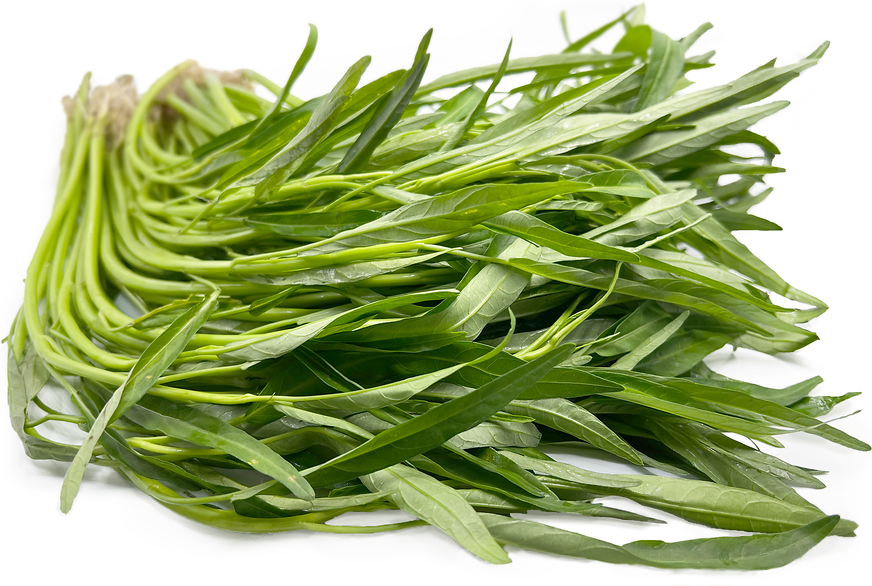
Kangkong Leaves
Estimated Inventory, lb : 0
Description/Taste
Kangkong leaves vary in size and appearance, depending on the specific type and age at harvest. The leafy stems are typically sold in markets when they have reached between 15 and 25 centimeters in length and are comprised of cylindrical, hollow stems and arrow-shaped to lanceolate leaves. The long and slender leaves are pointed, ranging from 2.5 to 15 centimeters long, and grow in an alternate pattern along the stem. The leaves are also dark green, feature prominent veining across the surface, and are pliable, being easily torn or creased. The pale green to green-white hollow stems can be small and narrow or larger and more open, as there are two main types found in markets. These stems are crunchy, crisp, and lightly aqueous. When cooked, Kangkong stems provide a tender, succulent crunch, contrasting with the leaves' slippery and soft consistency. Kangkong leaves are edible raw or cooked, but are primarily cooked, bearing a slightly sweet, vegetal, mineral-forward, green taste.
Seasons/Availability
Kangkong leaves are available year-round, with a peak season in the summer through early fall.
Current Facts
Kangkong leaves, botanically classified as Ipomoea aquatica, are a widespread species grown for culinary purposes belonging to the Convolvulaceae family. The tender leaves and stems develop along fast-growing, herbaceous, creeping vines and thrive in moist soil and aquatic areas in tropical and subtropical regions. Kangkong leaves are typically harvested 30 to 45 days after planting and are trimmed and bundled for sale in markets worldwide as a fresh, nutritious green. The name Kangkong, also spelled Kangkung, is a descriptor used in Southeast Asia, especially in the Philippines, Malaysia, Indonesia, and Papua New Guinea. The species is also commonly known as Water spinach, Ong Choy and Kong Xin Cai in Chinese, Bai Phai and Phak Bung in Thai, Giau Muong in Vietnamese, and Yosai and Kusinasi in Japanese. It is important to note that two main types of Kangkong leaves are seen in markets, labeled as Ching Quat and Pak Quat. Ching Quat types are also known as “green-stemmed” plants and have narrow stems and leaves. These types are mostly grown in soil and cultivated beds. Pak Quat, or “white-stemmed” plants, have arrow-shaped leaves and bear wider stems. This type primarily grows in aquatic environments. Kangkong leaves were once a wild species, but they were later selected as a commercially cultivated culinary crop. Worldwide, the species is now found in the wild, home gardens, and commercial farms. The plants have also escaped cultivation and have naturalized in regions worldwide, sometimes acquiring a reputation as an invasive weed. Kangkong leaves are a favored vegetable throughout Southeast, Southern, and East Asia and have expanded in culinary use to international cuisines. The stems and leaves are utilized in a wide array of fresh and cooked savory preparations.
Nutritional Value
Kangkong leaves are a source of iron to develop the protein hemoglobin for oxygen transport through the bloodstream and calcium and phosphorus to support bone and teeth health. The greens also provide other minerals like magnesium, potassium, manganese, and copper to balance fluid levels, help control nerve functions, produce red blood cells, and increase energy production. Beyond minerals, Kangkong leaves contain vitamins A, C, and K to strengthen the immune system, maintain healthy organs, and assist in faster wound healing. In natural medicines throughout Asia, Kangkong leaves are occasionally used as a natural laxative. They are also boiled, and the juice is mixed with water to apply topically as a cold compress to lessen fevers.
Applications
Kangkong leaves have a mild, vegetal, and subtle mineral-like taste suited for raw and cooked culinary preparations. Young, tender Kangkong stems and leaves can be eaten raw in salads, but the greens must be thoroughly washed before use. Some Kangkong leaves may be harvested from wild locations with varying sanitary conditions. In Southeast Asia, young shoots are sometimes eaten with green papaya or tossed in a peanut sauce as a chilled dish. Cooking the greens helps to protect against bacteria and food-borne illnesses. The leaves are separated from the stems before cooking, as they have different required heating times. Kangkong leaves and stems are traditionally stir-fried across Asia. The greens cook quickly and are served as a simple side or accompaniment to meat main dishes. Each region in Asia will add varying aromatics and sauces for enhanced flavoring. Common additions include sambal, which is a chili paste, and belacan, a shrimp paste, in Malaysia and Indonesia. In Taiwan and China, the greens are cooked with soy sauce, oyster sauce, and garlic. In addition to stir-frying, Kangkong leaves are blanched, simmered, or sauteed. In the Philippines, the greens are famously incorporated into adobo and sinigang recipes. In Vietnam, the stems are sliced into strips and eaten with noodles. Worldwide, Kangkong leaves are mixed into curries, soups, and stews, chopped into spring rolls, or coated in batter and fried to make a crisp appetizer. They are also pickled for extended use. Kankong leaves pair well with aromatics such as ginger, garlic, onions, and chile peppers, bay leaves, flavorings like vinegar, soy sauce, fish sauce, and sesame oil, cuttlefish, and meats such as poultry, pork, and beef. Whole, unwashed Kangkong leaves have a short shelf life and will only keep 1 to 2 days when stored in the refrigerator. It is recommended to immediately consume the greens for the best quality and flavor, as the stems and leaves are delicate and lose their water content quickly.
Ethnic/Cultural Info
Kangkong leaves are notably mentioned in a Filipino folktale. The story was famously documented in the book, “Philippine Folklore Stories,” written by John Maurice Miller in 1904, but may be much older than this record. The tale recounts the lives of two sisters, Mangita and Larina, who had different outlooks on life, and is set in the lake district of Luzon. Mangita was loved for her humble beauty, kindness, and strong work ethic. Her sister, Larina, was considered the opposite; she was cruel and vain and would spend her days combing her hair and catching butterflies instead of working. Legend has it that an old woman appeared to the sisters and asked for rice as she was hungry. Larina rejected the old woman, pushing her to the ground, causing the lady to cut her head on a sharp rock. Mangita rushed to the old woman to help her with her head wound and willingly gave the lady the rice she requested. Later in the story, the old woman returned to the two girls, as Mangita had become very ill. The old woman gave Larina magic seeds and asked her to give them to Mangita every hour to help her get better. Larina, in her cruelty, hid the seeds in her hair instead of giving them to her sister. When the old lady returned to find that Larina had hidden the seeds, she transformed into a beautiful fairy and banished Larina to reside at the bottom of the lake. The seeds hidden in her hair sprouted and formed a tangled, hair-like network of green plants across the top of the lake, giving rise to Kangkong.
Geography/History
Kangkong leaves are believed to be native to Southeast Asia and have been growing wild since ancient times. Much of the early history is debated among scientists, with some theories pointing to India as another center of origin. The first record of cultivated Kangkong leaves occurred during the Chin Dynasty in China sometime during the 4th century. Over time, the species was extensively cultivated and naturalized, spreading throughout Asia and into other regions worldwide. It was also carried and planted in new areas with migrating people groups as a culinary crop. The species was brought to Europe around the 16th century and to the United States in the mid-20th century. Today, Kangkong leaves thrive in warm, wet climates worldwide and naturally grow in soil and float across lakes and ponds. The species is commercially cultivated and collected from wild populations and is sold in fresh markets as a culinary ingredient. Kangkong is prevalent throughout Asia as a conventional crop and is more of a specialized green in other regions.
Recipe Ideas
Recipes that include Kangkong Leaves. One



